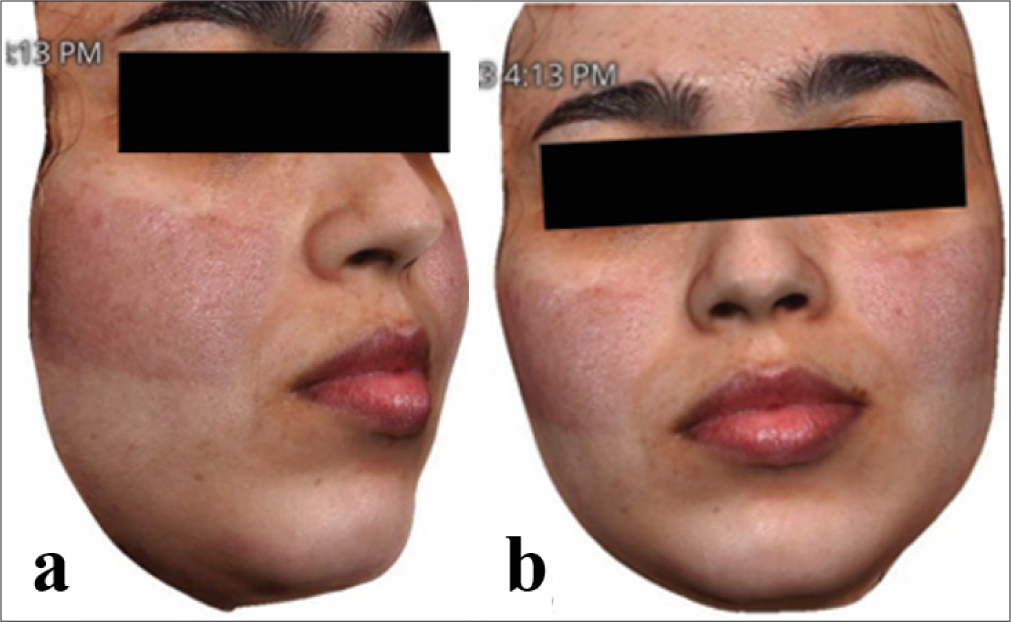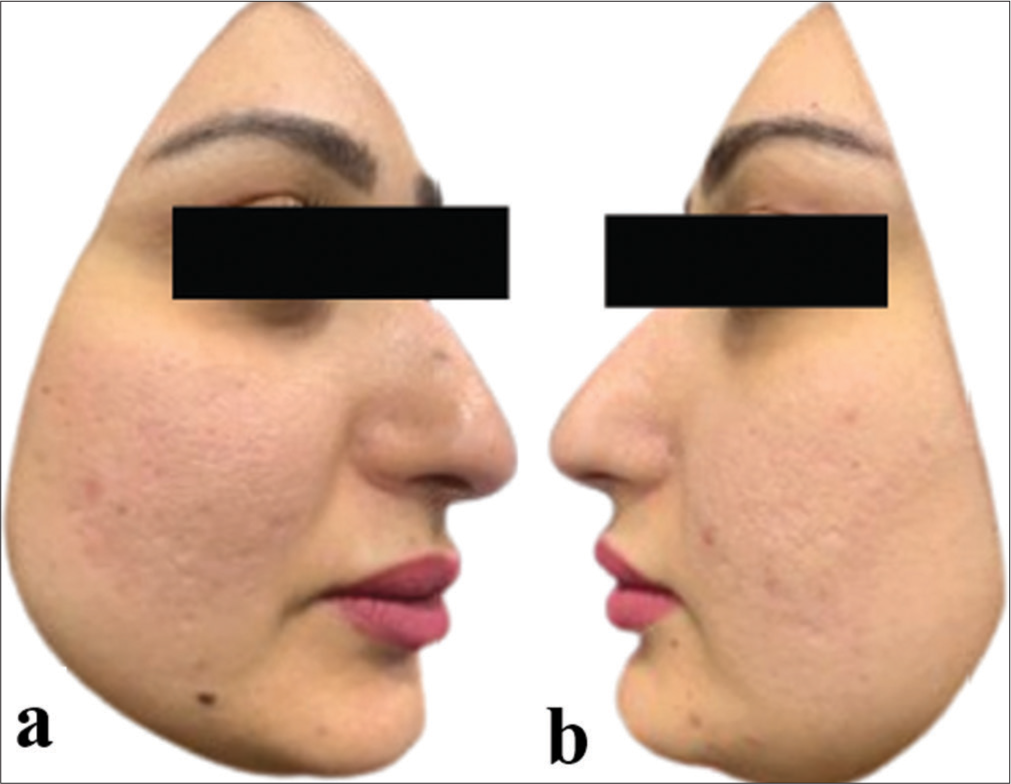Translate this page into:
Novel long pulse potassium-titanyl-phosphate with substructured pulses – An effective tool in treating post-inflammatory erythema: A report of two cases in darker skin
*Corresponding author: Rawan Almutairi, Department of Dermatology, Ministry of Health, Safat, Kuwait. r.mutairi95@hotmail.com
-
Received: ,
Accepted: ,
How to cite this article: Almutairi R, Usmani S, Mubarak S, Al-Daraji W. Novel long pulse potassium-titanyl-phosphate with substructured pulses – An effective tool in treating post-inflammatory erythema: A report of two cases in darker skin. J Cutan Aesthet Surg. doi: 10.25259/JCAS_18_2024
Abstract
The utilization of lasers is advancing as the range of applications for laser therapy expands, and new devices have been introduced. Vascular coagulation, pigment ablation, skin regeneration, tissue cutting or ablation, and hair removal are the five primary applications of laser therapy for the treatment of dermatological conditions. We present two cases of female patients with bilateral facial redness, one due to electromedical plasmage and the other from fractional carbon dioxide (CO2) laser, in which the target of their therapy was to improve acne scarring. Facial redness in both cases was successfully treated using a potassium-titanyl-phosphate (KTP) laser with cryogen cooling. The KTP laser has demonstrated efficacy in treating erythema associated with various conditions, including CO2 fractional laser and plasmage therapy. One of the advantages of the KTP laser is that it minimizes post-operative purpura and erythema, making it a favorable option for treating erythema itself.
Keywords
Potassium-titanyl-phosphate laser
Post-inflammatory erythema
Post-inflammatory purpura
INTRODUCTION
Laser technologies are a recent addition to the medical industry. They are currently used in many branches of medicine, including ophthalmology, gynecology, dermatology, otolaryngology, gastroenterology, and physiotherapy.1 The utilization of lasers is progressing as new devices are introduced, and the range of applications for laser therapy is expanding. Choosing a laser for a specific aim typically relies on the laser’s chromophore, which refers to the molecule or molecules that are most likely to absorb electromagnetic energy of a specific wavelength. Selective photothermolysis refers to the process of specifically targeting a particular chromophore. Water, tissue proteins, hemoglobin, and pigments such as melanin or tattoo pigment are the most often seen chromophores. Lasers that specifically focus on water and interstitial proteins have the ability to vaporize tissue, which is why they are referred to as ablative. On the other hand, lasers that specifically focus on hemoglobin and other pigments do not directly harm the tissue and are, thus, referred to as non-ablative. Carbon dioxide (CO2) and erbium-doped yttrium-aluminum-garnet lasers are widely utilized for ablative purposes. On the other hand, examples of non-ablative lasers are pulsed dye laser (PDL), potassium-titanyl-phosphate (KTP), and neodymium-doped yttrium-aluminum-garnet. Laser therapy used in treating dermatological conditions is commonly employed for five main purposes: Vascular coagulation, pigment ablation, skin regeneration, tissue cutting or ablation, and hair removal.2 Herein, we represent two cases of female patients with bilateral facial redness, first due to electromedical plasmage and second from fractional CO2 laser, which, in both cases used to improve acne scarring. Facial redness in the two cases was successfully treated using a KTP laser with cryogen cooling.
CASE REPORT
Case 1
A 28-year-old lady presented with 2 months history of bilateral facial redness. The condition started 2 weeks after a cosmetic procedure to improve her acne scarring using electromedical plasmage. The patient consulted many dermatologists and tried topical medications without clinical improvement, which led to a major psychological impact on her life. On examination, there was bilateral and well-demarcated facial erythema with hotness on palpation [Figure 1].

- (a) lateral and (b) anterior view of the patient’s face with post-inflammatory erythema secondary from electromedical plasmage.
Case 2
A 30-year-old lady presented with bilateral facial redness, which occurs as a complication of fractional CO2 laser for acne scarring; the patient tried topical plasma injections without improvement, and the skin turned so sensitive, which affected her social life. On examination, there was bilateral, well-demarcated facial dusky erythema and hotness on palpation [Figure 2].

- (a) right and (b) left side of the patient’s face with post-inflammatory erythema secondary to fractional carbon dioxide laser.
Both patients underwent treatment of full face using the 532 nm KTP laser (DermaV; Lutronic Inc.) Four sessions, 2 weeks apart, the whole face was treated using a 12 mm diameter spot size at an energy of 5–7 j/cm2 using a 10 ms pulse duration and a sub-milli-mode or sub-micro-mode setting, a 15 ms cryogen spray was given before and during laser pulse without post cooling spray (a setting of 15/15/0). Elidel Cream (Pimecrolimus) was used twice daily between the laser sessions. The quantificare system was used to acquire pictures of the facial area of each patient.
On a session-by-session basis, two dermatologists who were blinded and independent of the primary treating physician evaluated the photographs and assigned improvement ranges of <25%, 25–50%, 50–75%, and >75%. Both dermatologists agreed on improvements of 50–75% [Figures 3 and 4].

- (a) lateral and (b) anterior view of the patient’s face showing significant erythema resolution after four sessions of long potassium-titanyl-phosphate laser.

- (a) right and (b) left side of the patient’s face showing significant resolution of the erythema after four sessions of long pulse potassium-titanyl-phosphate laser.
DISCUSSION
Erythema, or redness of the skin, is a common side effect of CO2 laser treatment that can last for an average of 4.5 months and even up to 9 months following CO2 laser treatment.3 Fractional laser resurfacing as monotherapy is effective in treating acne scars; however, aggressive treatment parameters in fractional CO2 laser resurfacing may lead to adverse effects, including severe erythema.4 On the other hand, erythema or redness has not been previously documented in the literature following the use of plasmage electromedical therapy. Yet, this was noticed in our patient.
The treatment of post-inflammatory erythema has been a subject of interest in various medical studies. Different modalities have been explored for their efficacy in the treatment of erythema. It has been demonstrated that the use of a KTP laser combined with topical retinaldehyde can improve total erythema and telangiectasia.5 In addition, another study found that the 577 nm pro-yellow laser was highly effective in the treatment of post-acne erythema.6
Moreover, authors reported a variable response of post-Mohs surgery telangiectasias to KTP laser, suggesting its potential in treating erythema.7
The effectiveness of the KTP laser in treating diffuse erythema has not been as thoroughly confirmed as that of PDL. However, a small randomized study conducted by Uebelhoer et al.,8 compared the 532 nm KTP laser with the 595 nm long-pulsed PDL for the treatment of telangiectasias and diffuse facial erythema. The results showed that after three treatments, the KTP laser led to an 85% improvement in erythema, while the PDL led to a 75% improvement. This indicates that the KTP laser is effective in addressing erythema.
The use of KTP laser therapy in this context is advantageous because erythema is the consequence of increased blood flow to the skin and the dilation of cutaneous blood vessels. This is not only because it targets the blood vessels but also because the target blood vessels are not ruptured, leading to much less purpura. This was as a result of the pulsation duration. Longer pulse lengths enable the delivery of laser energy to vessels for extended periods, thereby reducing vessel rupture and accompanying hyperpigmentation. In addition, they produce mild homogeneous heating or coagulation throughout the entire vessel. The first laser to consistently eradicate linear vessels without purpura and produce vessel blanching during treatment was the KTP laser, which had a pulse duration of 150 ms.9 The implementation of cryogen spray cooling effectively eliminated dyspigmentation in KTP lasers. This has been extensively investigated and implemented in dermatologic laser surgery to help maintain the epidermis during a variety of procedures. Due to its selective cooling effect on the superficial layers of the skin, it is a valuable technology for reducing thermal injury to the epidermis during laser therapy.10
CONCLUSION
KTP laser has demonstrated efficacy in treating erythema associated with various conditions, including CO2 fractional laser and plasmage therapy. One of the KTP laser advantages is that it minimizes post-operative purpura and erythema, making it a favorable option for treating erythema itself. Thus, the KTP laser represents a new promising treatment modality in treating erythema and makes it a valuable option for dermatological treatments.
Authors’ contributions
Taking responsibility in patient management, patient follow-up, and data collection including photography; Wael Aldaraji and Sarah Mubarak. Taking responsibility in interpretation and presentation of the results; Rawan Almutairi, Sarah Mubarak, and Wael Aldaraji. Taking responsibility in the construction of the whole or body of the manuscript; Rawan Almutairi and Wael Aldaraji. Reviewing the article before submission not only for spelling and grammar but also for its intellectual content; Rawan Almutairi, Saima Usmani, Sarah Mubarak, and Wael Aldaraji. All authors reviewed the case and approved the final version of the manuscript.
Ethical approval
The Institutional Review Board approval is not required.
Declaration of patient consent
The authors certify that they have obtained all appropriate patient consent.
Conflicts of interest
There are no conflicts of interest.
Use of artificial intelligence (AI)-assisted technology for manuscript preparation
The authors confirm that there was no use of artificial intelligence (AI)-assisted technology for assisting in the writing or editing of the manuscript, and no images were manipulated using AI.
Financial support and sponsorship
Nil.
References
- Laser complications In: StatPearls. Treasure Island, FL: StatPearls Publishing; 2023. Available from: https://www.ncbi.nlm.nih.gov/books/NBK532248 [Last accessed on 2023 Aug 28]
- [Google Scholar]
- A prospective study of fractional scanned nonsequential carbon dioxide laser resurfacing: A clinical and histopathologic evaluation. Dermatol Surg. 2009;35:222-8.
- [CrossRef] [PubMed] [Google Scholar]
- Severe neck scarring: A consequence of fractional CO2 laser resurfacing. J Cosmet Laser Ther. 2016;18:352-4.
- [CrossRef] [PubMed] [Google Scholar]
- Physical modalities for the treatment of rosacea. J Dtsch Dermatol Ges. 2016;14(Suppl 6):38-43.
- [CrossRef] [Google Scholar]
- An evaluation of the efficacy of a single-session 577 nm pro-yellow laser treatment in patients with post-acne erythema and scarring. Dermatol Ther. 2021;34:e14611.
- [CrossRef] [Google Scholar]
- Variable response of post-Mohs surgery telangiectasias to KTP laser: A case report. SAGE Open Med Case Rep. 2018;6:2050313X18802409.
- [CrossRef] [PubMed] [Google Scholar]
- A split-face comparison study of pulsed 532-nm KTP laser and 595-nm pulsed dye laser in the treatment of facial telangiectasias and diffuse telangiectatic facial erythema. Dermatol Surg. 2007;33:441-8.
- [CrossRef] [PubMed] [Google Scholar]
- A new 532 nm, variable-pulse-structure, dual-wavelength, KTP laser incorporating cryogen spray cooling effectively treats rosacea. Lasers Surg Med. 2023;55:734-40.
- [CrossRef] [PubMed] [Google Scholar]
- Cryogen spray cooling and pulsed dye laser treatment of cutaneous hemangiomas. Ann Plast Surg. 2001;46:577-83.
- [CrossRef] [PubMed] [Google Scholar]







